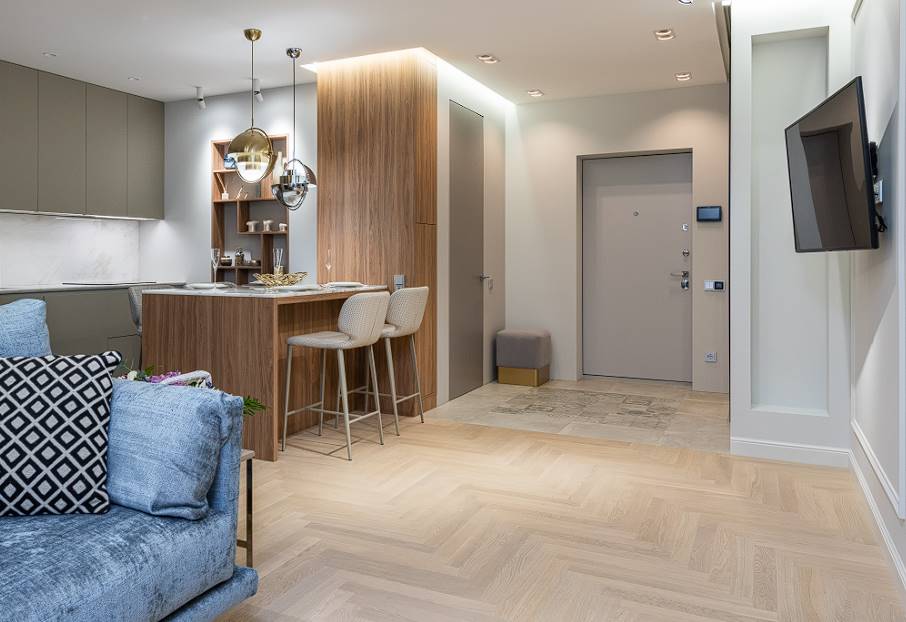Understanding how to insulate your floor based on its specific type is crucial. However, opting for the appropriate floor insulation offers numerous advantages, making it highly worthwhile for you and your household.
Floor insulation offers a multitude of benefits. It enhances the warmth of your home, making the rooms more comfortable. Additionally, it significantly improves energy efficiency, resulting in reduced utility bills.
It is widely known that warm air rises while cold air sinks. Consequently, many of us endure the discomfort of cold floors in our homes without considering alternative solutions. Even if you have experimented with various thermal socks and cozy slippers, the problem might be more complex than finding suitable footwear.
Your home should serve as a haven during colder months, and you shouldn't have to rely on layering socks to navigate within it.
The issue might lie within your floor, especially if it is located on the ground level or, worse yet, in the basement. Floors made of ceramic, stone, or concrete are particularly problematic, with hardwood floors following closely.
You need not look further if you seek detailed information on effectively insulating a cold floor. In the following article, we comprehensively explain the best methods to insulate your floor.
The Basics of Underfloor Insulation
The lowest temperatures in your home are typically found near the floors, and materials like stone, wood, or linoleum easily transfer the cold air, resulting in a cool surface to touch.
While underfloor heating systems can be an option, they involve complex installation and can be expensive. In many cases, a more cost-effective solution would be to replace your flooring with a material that is less affected by temperature, such as carpet.
However, you don't have to give up on your hard flooring. An alternative approach is to insulate the area beneath your floor to shield it from cold temperatures during the winter.
Floor insulation can be achieved by sealing the ground and floor space, specifically in the gaps between the floor's supporting beams. This is commonly done using fibreglass insulation rolls cut to fit the space. However, it's important to note that this type of insulation ages quickly and can absorb moisture from the ground. This moisture can then seep into the floors, leading to deterioration, wet surfaces, and slippery floors.
What Type of Floor Do I Have?
Many houses, particularly newer ones, have ground floors constructed with solid concrete. Insulation can be added during the floor replacement or by placing rigid insulation on top.
On the other hand, older homes often have suspended timber floors. You can determine if your house has a suspended timber floor by checking for air bricks or ventilation bricks below the floor on the exterior walls.
It is crucial not to block up these air bricks in your walls, as they are vital in ventilating the space beneath your floor and preventing floorboard rot.
If your house has a basement or cellar that is safely accessible, examining it will help you identify the type of floor you have. If it is a suspended wooden floor, you will likely see wooden joists and the undersides of the floorboards.
If you can't access the space beneath your house, lift a corner of the carpet and underlay it to inspect the floor visually.
Reasons Why Your Floor Is So Cold
Gaining insight into the elements that contribute to cold floors can assist you in finding solutions, resulting in improved comfort and potential energy bill savings. Here are several typical factors that can cause cold floors:
Your Home's Floors Don't Have Enough Insulation.
Without adequate underfloor insulation, your home may lack a crucial barrier between the floor and the cold air beneath it. Insulation is a barrier that restricts heat transfer, preventing the warmth from escaping through the floor. Consequently, the flooring retains the generated heat, creating a more comfortable environment during chilly weather.
The Cold Air Is Getting in Through Holes in the Floor.
In colder seasons, gaps in the flooring can pose a significant problem for households that need proper sealing and insulation measures. While it is true that cracks in the floor can worsen the situation, sealing these gaps will only provide a minor improvement and not address the underlying cause of the problem.
The Heating System is Not Good Enough
Although multiple factors typically contribute to cold floors, it's important to note that a sub par heating system can also affect the floor temperature. However, it's worth considering that even with a high-quality heating system, cold floors can persist without proper underfloor insulation.
Tips on How to Insulate Cold Floors
When it comes to installing underfloor insulation, it can present some challenges. To help you overcome these challenges and ensure a successful installation, here are a few helpful tips:
Keep Cold Air Out, Warm Air In
Begin with the most straightforward approach, aiming to achieve a comfortable temperature throughout your house, not just the floor. Take measures to eliminate drafts and prevent heat loss by sealing gaps or cracks in the walls, baseboards, or floors using caulk or other suitable sealants. Additionally, consider installing or replacing weatherstripping around your windows and doors and using a draft snake to reduce drafts further.
Another effective strategy is to insulate the ceiling. Since hot air naturally rises, it would be unfortunate to waste the warm air generated by your HVAC system by allowing it to escape through the ceiling. Insulating the ceiling helps to retain the heat within your living space.
Make Use of Rugs
This straightforward and enduring method not only provides warmth but also enhances the overall ambience of a space. For example, you can create cozy conversation corners and inviting reading nooks within a larger room by strategically placing area rugs. These rugs can also be placed near beds, doorways, and bathrooms where people often walk barefoot, offering cushioning and warmth to the floor.
Measure and Cut Accurately
Before cutting the insulation material, measuring the dimensions of your floor space accurately is crucial. This step ensures that the insulation will fit properly without gaps or overlapping sections, which can compromise its effectiveness. You can ensure a snug and efficient insulation installation by taking precise measurements and cutting the insulation accordingly.
Insulate Underneath
If your floor is above a crawl space that isn't heated, you should put insulation between the floor joists. Regularly check the condition of the insulation, as insects or critters may occasionally enter the crawl space and cause damage. Moreover, the natural settling of your home can dislodge the insulation. To avoid these issues, consider spray foam insulation, which is more expensive but highly efficient than fibreglass insulation.
Even though unfinished basements tend to be warmer than crawl spaces, insulating the basement will still contribute to maintaining a comfortable temperature on the floor above. Likewise, when dealing with bonus rooms above a garage, insulation and sealing is crucial to prevent cold drafts and act as a barrier against carbon monoxide. Nonetheless, installing a carbon monoxide monitor for safety is still necessary.
Insulate the Floor and Rim Joists
In first-story floors constructed with joist platform construction, the joist spaces located above unheated basements or crawlspaces are susceptible to heat loss through the floors. To address this issue and improve the warmth of the floors, it is recommended to insulate them using fibreglass batt insulation.
Another potential source of cold air circulation through the joist cavities beneath the floor is the rim joist areas where the flooring platform meets the foundation. Insulating the rim joists and headers can effectively enhance the warmth of the floors by minimising cold air infiltration.
Insulate on Top
If your home has a concrete slab foundation and you intend to install new flooring, it is advisable to incorporate a layer of rigid insulation beneath the flooring material. This insulation helps to prevent heat loss and adds a layer of thermal protection.
When you don't have immediate plans to replace the existing floors, a simple and temporary solution for insulation is placing area rugs during the winter months. These rugs provide some insulation and help create a warmer and more comfortable environment.
However, it's important to note that installing wall-to-wall carpeting directly over an uninsulated and unheated concrete slab can pose a problem due to the potential for mildew growth. Moisture can accumulate without proper insulation and ventilation, leading to mildew development. Therefore, it's crucial to consider proper insulation measures before installing wall-to-wall carpeting on a concrete slab.
Wear Protective Gear
When working with insulation materials, it is essential to prioritise your safety. Wear the right safety gear, like gloves, goggles, and a mask, to protect yourself from particles that could cause irritation or harm. These items will help minimise the risk of skin irritation, eye irritation, and inhalation of harmful particles that may be present in the insulation materials. Safety should always be a priority when handling any construction or insulation materials.
Get the Best Performance from Your Heating System
To ensure optimal performance of your heating system, it is important to conduct regular inspections and maintenance. For example, alongside cleaning the furnace filter, ducts, and heat registers, it is essential to check that the registers are not obstructed by furniture or drapes and remain connected to the ductwork. By adhering to these maintenance practices, you can maximise the efficiency and effectiveness of your heating system.
Follow the Manufacturer's Instructions
It is vital to carefully read and adhere to the manufacturer's instructions that accompany the insulation you are installing. By following these instructions closely, you can ensure that the insulation is installed correctly and following the manufacturer's recommendations.
Add Extra Heat
When you need to remain stationary for extended periods, such as when working at a desk in your home office, a small space heater can be suitable for keeping your feet warm. Alternatively, under-cabinet heaters, known as "toe kick" heaters, are slightly more costly but more effective as they blow warm air across the floor. For the utmost comfort, underfloor radiant heating is considered a luxurious option. However, it is a significant home improvement project that a qualified heating professional should undertake. In addition to the heating installation itself, this project necessitates installing new flooring and establishing a dedicated 20-amp circuit.
Ensure Insulation Is Properly Secured
To maintain the effectiveness of your insulation over time, it is important to securely fasten it using appropriate methods such as fasteners, strapping, or staples. This helps prevent sagging or shifting of the insulation, which could compromise its performance. In addition, properly securing the insulation can ensure its long-term stability and effectiveness in providing thermal insulation.
DIY or Professional?
Not all insulation work in your home requires professional assistance. For smaller tasks, tackling them yourself can often be more cost-effective.
To reduce draughts, you can easily seal the gaps between floors and skirting boards using sealant available at any DIY store.
Insulating an unheated cellar or basement underneath your timber floor becomes even simpler if you have access to it. But first, ensure that the joists supporting the floorboards are in good condition and free from any signs of wet or dry rot.
Once the joists are deemed safe, you can insert insulation between them and secure them with netting if needed. For fire resistance, fix the plasterboard directly to the undersides of the joists, creating a "ceiling" for the basement. Additionally, you can install more rigid insulation underneath this "ceiling" to enhance the insulation further.
When reinstalling the floorboards, please try to seal any gaps between and around them.
Furthermore, placing rugs or carpets on the floor will provide added warmth to your feet, potentially reducing the need for excessive heating. By implementing these measures, you can improve insulation in your home without relying solely on heating systems.
Challenges of Installing Underfloor Insulation
Underfloor insulation installation can pose challenges that vary depending on several factors. One prominent factor is the restricted crawl space beneath the flooring. In many cases, this space is limited, which might require you to maneuver while lying on your back and install the insulation above your head. This can make the process somewhat challenging and require additional effort to ensure proper installation.
Conclusion
The information on how to insulate a chilly floor is the most crucial part of this document. Although under-floor heating systems have certain advantages, they can be costly and difficult to set up. Sealing the ground and floor area using fibreglass insulation rolls trimmed to size is one method of achieving floor insulation. However, this insulation can become deteriorated, damp, and slippery if it absorbs rainwater from the ground. Many homes, especially newer ones, feature concrete slabs for basement floors.
It is possible to insulate the floor either by installing rigid insulation over it or by doing so at the time of replacement. Checking for air bricks or ventilation bricks below the floor on external walls is a telltale sign of a suspended timber floor, which is common in older homes. Poor underfloor insulation, air leaks from the floor, and a weak heating system all contribute to the chilliness of your home's flooring. Important details include caulking any holes or cracks in the walls, baseboards, or floors; installing or replacing weatherstripping around windows and doors; using a draught snake to seal air leaks; insulating the ceiling; using rugs; accurately measuring and cutting materials; insulating underneath; insulating the floor and rim joists; and installing a carbon monoxide monitor for peace of mind.
The house as a whole, not simply the floor, will benefit from these precautions. If you want warmer floors, insulation made of fibreglass batts is what you need. It is also important to insulate the rim joists and the headers to keep the heat within the house. Putting down an area rug can help insulate the room and make it feel cosier. To get the most out of your heating system, do things like following the manufacturer's recommendations and wearing protective gear, and adding extra heat if necessary.
Although it's a nice luxury to have, installing radiant heat pipes under the floor takes a trained heating technician. If you want your insulation to last a long time and do its job, make sure to attach it properly. Smaller jobs may be better handled by the homeowner or with minimal outside help. Eliminating draughts can be as simple as caulking the space between the floor and the skirting boards. Making sure the joists are in good shape and securing them with netting before installing insulation in an unheated cellar or basement is essential.
Plasterboard can be fastened to the undersides of the joists to create a "ceiling" for the basement; this will allow you to cover the concrete floor with rugs or carpets without worrying about water seeping in through the cracks in the joists. The crawl area under the flooring can make or break the process of installing underfloor insulation.
Content Summary
- Insulating cold floors offers numerous advantages for comfort and energy efficiency.
- Floors made of ceramic, stone, concrete, or hardwood can be particularly cold.
- Understanding the type of floor you have is crucial for effective insulation.
- Underfloor heating systems can be complex and expensive; replacing flooring with a less affected material like carpet can be a cost-effective solution.
- Sealing the ground and floor gaps with fibreglass insulation rolls can insulate the floor, but it can age quickly and absorb moisture.
- Solid concrete is common in newer homes, while older homes may have suspended timber floors.
- Lack of insulation, gaps in the flooring, and subpar heating systems can contribute to cold floors.
- Eliminating drafts, insulating the ceiling, and using rugs can help keep the floors warm.
- Accurate measurement and cutting of insulation material are essential for effective installation.
- Insulating the crawl space or basement beneath the floor can improve floor temperature.
- Insulating floor joists, rim joists, and headers can minimise cold air infiltration.
- Rigid insulation can be placed beneath concrete slab foundations to prevent heat loss.
- Safety gear should be worn when handling insulation materials.
- Regular maintenance and inspections are necessary for optimal heating system performance.
- Following the manufacturer's instructions is important for correct installation.
- Small space heaters or under-cabinet heaters can provide extra heat for specific areas.
- Properly securing insulation ensures long-term stability and effectiveness.
- Some insulation tasks can be done as DIY projects for cost-effectiveness.
- Sealing gaps between floors and skirting boards can reduce draughts.
- Insulating unheated cellars or basements can be simplified with access and proper joist condition.
- Challenges in underfloor insulation installation include restricted crawl space and maneuvering difficulties.
- Insulation helps retain generated heat and creates a more comfortable environment.
- Sealing gaps in flooring prevents cold air from entering the house.
- Subpar heating systems can affect floor temperature even with insulation.
- Eliminating drafts and insulating the ceiling help retain heat in the living space.
- Area rugs provide warmth and improve the ambience of a room.
- Accurate measurement and cutting of insulation material ensure proper fit.
- Insulating between floor joists in crawl spaces or basements improves floor warmth.
- Insulating rim joists and headers minimises cold air infiltration.
- Rigid insulation beneath concrete slab foundations prevents heat loss.
Frequently Asked Questions
An electric radiant floor heating system uses electric heating wires to heat the floors. Installation is quick and incredibly energy efficient. Electric systems are also cost-effective and less expensive to install (compared to other heating systems), especially when considering long-term electricity costs.
Under-rug heaters are a cheaper and easier alternative to keep your floor warm without underfloor heating. This can range from insulating pads to chargeable heated options underneath your rugs.
Solid floors are insulated using rigid foam, fitted above or below the concrete. If the concrete is above the insulation, it can sometimes store heat during the day, which helps keep the room warm at night.
A cheaper and easier option for insulating a concrete floor is to line it with chipboard sheets and then carpet over the top. Using a high-quality rubber underlay will further add to the feeling of warmth. This will be warmer than proper insulation, but it will make a noticeable difference.
Improving your home's insulation is the main way to battle heat loss through floors, walls, windows, and roofs. You can either install more insulation or ensure no gaps in the existing insulation, as adequate insulation keeps heat loss to a minimum.







